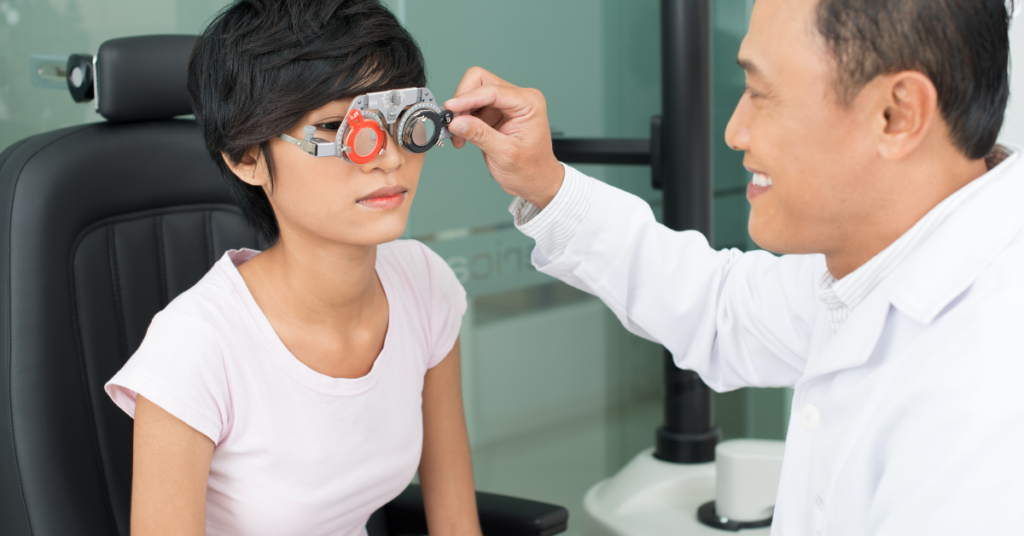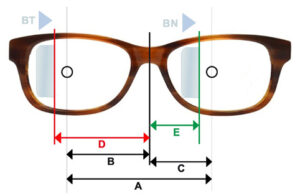Contents
What is Prism Correction?
Correct vision is when both your eyes are working correctly to convert the individual pictures captured by them to a final picture of what we see. Due to various reasons, this procedure fails and the person sees two separate images instead of one. Prism correction is the correction of the convergence error which causes this double vision.
Working of Prism Correction
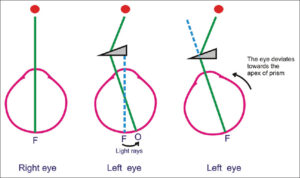
In the working of an eye, light enters and passes through the cornea to fall on the retina at the back of the eye. This mechanism helps to see one image of the object because light falls on the same part of the retina. When the light passes and falls on different parts of the retina of each eye. It causes double vision, which is when you see two images of one same object.
What Is Prism In Prism Correction Eyeglasses?
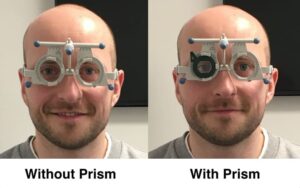
To correct the weakness in your eyes, the Doctor places a prism in a specific location and a specific power to correct the weakness of eye muscles. The prism bends the light before it travels through the eye. The light gets redirect on its path, it falls correctly on the same part of the retina in each eye. The brain, therefore, does its job, fuses the individual images produced by each eye into a correct and clear image.
Why Do You Need Prism Correction Glasses?
A person suffering from Diplopia ( Double Vision), Hemianopia ( Partial Blindness) needs Prism correction glasses. Athletes also use them, which helps them to improve their performance with enhanced vision.
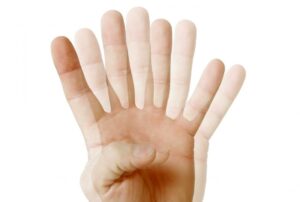
- Diplopia: Diplopia is a situation when you see two images instead of one. Diplopia can either be in one eye or both eyes. Double Vision in one eye is monocular diplopia. This can involve the cornea, lens, cataracts, brain, etc.
Symptoms
- Pain around eyes
- Weakness
- Headache
 Hemianopia: Hemianopia is a situation when a person loses his partial vision.
Hemianopia: Hemianopia is a situation when a person loses his partial vision.
There are two types of Hemianopia :
- Homonymous Hemianopia is the most common type and affects different parts of the visual field but in the same eye.
- Lesion on optic chiasm (area in the brain where optic nerve forms an X) causes Heteronymous Hemianopia
Symptoms
- Not visible from the affected side
- Hallucinations
- Visual Negligence
Prism Correction Glasses And Related Tests
Eye test for the diagnosis of Prism:
Hirschberg Test
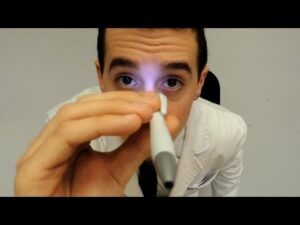
Hirschberg Test (Corneal light reflex test) is a very simple and quick way to check the ocular alignment. This is for the testing of strabismus (misalignment of the eyes) in newborns, young children, patients who have poor vision, etc. Doctors use a light source such as a penlight and tell the patient to focus on the light source. They observe the reflection of the light on the cornea, which should be on the same point of the white light near the center of each eye.
If the alignment is normal, the reflection will be in the same position in the pupil. If there is a misalignment in the eye, the reflection will be off the center of the pupil. The difference in the position of the reflex will be in the opposite direction as eye deviation. The type of eye deviation is as follows:
- Esotropia is when there is an inward deviation of the eye, the reflection of the light will be in the opposite direction.
- Hypertropia is when there is an upward deviation in the eye, and the reflection of the light displaces from the center of the pupil.
15 diopters (approximately 7 degrees from center) of prism corrects every 1 millimeter of deviation.
 Krimsky Test
Krimsky Test
This test is to measure the degree of misalignment. This is the same Hirschberg test but with a prism. Doctor asks you to look at the penlight, he/she places different prisms of different strengths in front of your eye. When the prism brings the reflection in each eye to the center, the device detects the correct prism measurement and measures it. The doctor advises this test for those who suffer from tropias (deviation of the eye when the eyes are open) not for those who suffer from phoria ( misalignment when binocular fusion view is broken).
Cover Tests
Cover testing is a method that is used to determine the presence, type, and magnitude of misalignment ( strabismus). It can be done at both near and far distances. If it is performed near, a target is fixed at a distance of 33 cm, and If at distance the target is set at approximately a distance of 6 meters. This test is very important for finding strabismus.
There are three types of Cover tests:

- Cover-uncover test: This is the test that is done earlier in the process. The procedure is to cover one eye using a cover to observe the movement of the eyes. This test is to examine if there are any signs of heterophoria or phoria present.

- Alternate- cover test: This test is generally performed after the cover uncovers test. This is a test to see the full deviation and if there is any phoria present by suspending binocular fusion. This test involves covering one eye for seconds to suspend fusion and then shifting to the other eye and continuously repeating the same without allowing binocular fusion in the patient’s eye. The faster the eye can recover, the better the control of deviation,

- Alternate prism cover test: This test is very similar to the alternate cover test, adding prism to one eye to find the quantity of misalignment. This is performed by placing prisms of different strengths incorrect directions over the non- fixating eye till there is a shift in fixation in either eye. The magnitude of deviation is the measurement of prisms (in diopters), that is required to neutralize the deviation in the eye.
Prescription Of Prism Correction Glasses.
A general prism glass prescription contains two numbers that are:
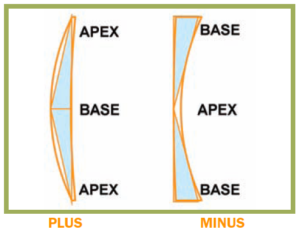
- Like normal eyeglasses, diopters (a unit to measure the misalignment ) are to indicate that the eyes are misaligned.
- The doctor places a prism after measuring double vision according to your ailment. ‘Base’ is the edge of the prism that defines where the light gets redirect. It can be anywhere.
Other Terms In Prescription

- OS and OD mean Oculus dexter and Oculus sinister respectively which are the Latin words for the right eye and left eye. OU stands for Oculus Uterque which means both eyes. On the Prism Correction glasses prescription, the information about the right eye comes before the term for the left eye. This stands for a reason that is if the doctors come in contact with you, your right eye comes in their sight fist as it is on their left and then your left eye because it appears to be on their right.
- SPH depicts the lens power which is measured in diopters and is prescribed to correct farsightedness and nearsightedness. If the number that is on your prescription contains a minus (-) sign, this means you suffer nearsightedness (Myopia). The number on the prescription is positive, or it does not have any sign, it is farsightedness (Hyperopia). If there is no correction, this means it is written as 0.00 or PL.
- CYL is the lens power to correct Astigmatism (an imperfection in the curvature of the eye). Astigmatism is the light coming into the eye from two focal points. To correct this ailment, SPH power is used to move one focal point to the retina and CYL power to another focal point in the retina. CYL column is blank, which means there is no astigmatism or it is so minimal that an eyeglass lens is not needed to correct it. If the column has a minus sign, it is for nearsighted astigmatism. If the column has a plus sign, it is farsighted astigmatism. CYL power is always written after SPH in a prism correction prescription.
- Axis number is the value between 1 and 180. If a prescription contains Cylindrical power, it must contain an axis and vice versa.
Tips To Use Prism Correction Glasses
There are many new experiences a patient experiences when you wear a prism correction glass. There are some instructions to use prism correction glasses correctly.
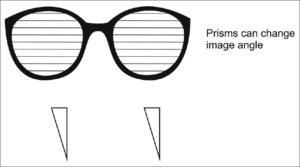
- You have to wear these glasses on regular basis i.e putting them in the morning and removing them after night.
- If the patient has no progressive lenses in their glasses, look at the object by pointing your nose at the object.
- Some patients may feel a little bit of strain on the eyes at the start and it may take some time for them to adjust.
- Staring at the ground, if they walk becomes a difficult task for those who think they have become taller and there is no weight on their head.
- Some feel improvement in their neck strain and neck elongation.
- The alignment of your face is the most important as it matters the most in correction glasses.
- If the patient finds sleeping in dark is easy, he/she can use a sleeping mask after removing the glasses.
- Some patients report a difficult time when they take off the glass while showering. You can use an eye patch on one eye after removing the glass.
- The muscles around become very tense and tight due to the ailment. Using the lens can ease down your muscles, and ease down your symptoms. Your alignment may change frequently. It is a part of the prescription and a modification in prescription helps.
- The correction glasses are different for every customer. Some may take a little time to adjust to these while some can adjust to them immediately after they wear them.
Side Effects Of Prism Correction Glasses
Side effects caused by using prism eyeglasses :

- Eye pain
- Eyestrain
- Headache
- Misaligned Eyes
- Double Vision
Reasons for the discomfort caused by prism correction glasses:
- Misalignment of lenses- Due to regular use of prism correction glasses, they can get misaligned. You can correct them by readjusting the glasses which will make the situation better and reduce the discomfort.
- Incorrect or Expired prescription: Another reason can be a wrong or expired prescription for prism correction. This will hurt your eye and your vision and can cause several side effects. Make sure your prescription is up to date
In all the above cases, consulting a doctor is very important because it can surely help you.
A Word From Mantra care
Prism Correction is a basic ailment that can happen to anyone, If you are feeling headache, eye pain and mainly you are experiencing double vision. Visit your nearby doctor as delaying the cure can cause severe eye problems, even causing your vision loss. Correct glasses and correct prescription is a very important factor in Prism Correction.
Here at Mantra Care, we have an incredibly skilled team of health care professionals who will be happy to help you out. For any assistance regarding diabetes and other related issues, you can reach out to us at +91-9711118331, [email protected], Or download our app- Android, iOS

